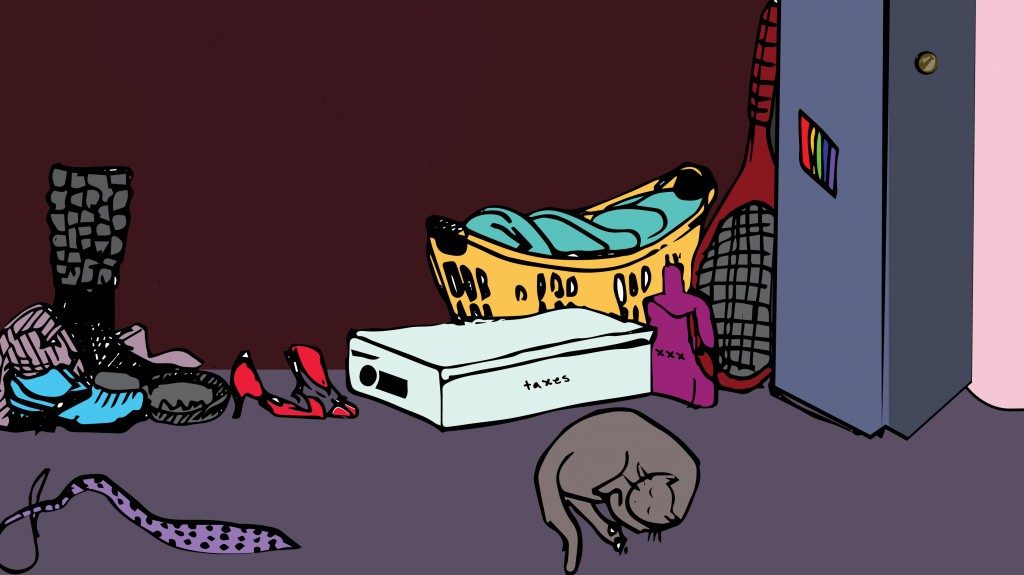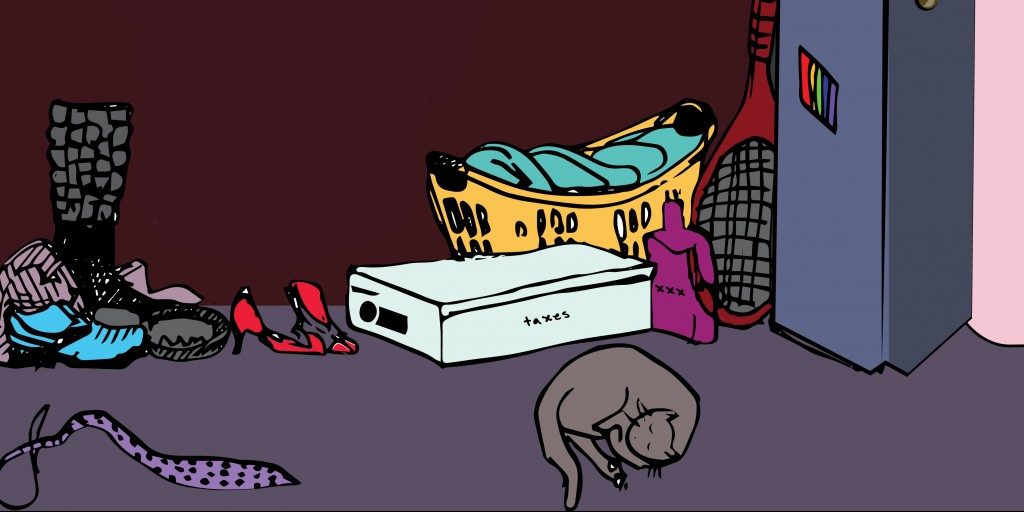
By Cara Seccafien, Layout Manager
Drinking is super fun. Don’t let anyone tell you otherwise. A glass of pinot noir or a pint of pale ale brings warmth to your cheeks, to your body, to your soul. A few more and everything is thrilling. Ordering it at a bar or a restaurant makes you feel adult, independent, smart. It’s even fun to say it: “Pale Ale, Paleale, Paleale. One more paleale, please.” Makes you feel like a butch sailor.
Liquor unearths vulnerability, which develops compassion and community. Learning more about beers or wines or liqueurs makes you feel like you are part of a very cool club. Your membership card displays how many drinks until you drop.
I love a good party—the ambiance, the performance, the schmoozing—and it is ostensibly impossible without a little elixir. When you fall asleep that night, the party continues on in your drunken dreams. Liquor makes us feel safe in our bodies, and against other bodies. Liquor brings out the truth. Being drunk is a revelation. I absolutely adore it.
However, the revelation is obscured—15 second snippets in poor lighting with no distinct beginning or end. Forgetting can be liberating. But obscurities in excess, being drunk two to three times a week for months at a time, keeping hangovers at bay with a few drinks in between, that is a prison. Disassociating all of the time is horrifying. Alcohol is actually a depressant (who knew!?), a diuretic, and a poison. Drinking every day feels like half your body is on leave.
Four months ago, the morning after a backyard kegger, I found myself with little recollection of the night before. There was nothing special about this night, except that I decided it would be the last one like it for a while. Maybe forever. When I “quit drunking” (I’ve had four drinks in the last four months, and no, they were not all at once), I became lucid.
I was a patient in a women-identified harm reduction addictions program called Sisters Together Active in Recovery (STAR). I realized that I was using alcohol to avoid fully embracing my queerness. I came out very young. As an urban kid of the ’90s I thought being gay was pretty cool. At 12, I told all my closest friends that I was bisexual. I managed my coming out like a complete boss, and felt empowered. By 15, I had a girlfriend, and it was amazing. Being gay was the bomb. Guys said dumb things at school when we kissed in the hallway, and I felt like I was in a secret club they would never get to be a part of. I felt strong because I had figured everything out so young. I had defied all odds! I was a Queen!
And then my mother found out. After she kicked me out, I supported myself in a one bedroom with my sister and graduated high school. And then just like that, I shimmied back into the closet as though I had never left it. Just like that, I found a place to store my queerness—in my drunken revelations. I was on my own, so I could drink when I wanted to. I didn’t drink often at first, but I nearly always got drunk.
I used drinking to express my true feelings to girls I was crushing on, to be vulnerable, to seek pleasure, to admit my desires. I should add that I was never a prude and I was never really closeted in the traditional sense of the word. Most everyone knew I was at least half gay. I had a lot of sex growing up and it was pretty safe. I attempted to embody feminism as a teen. I grew up atheist and did not suffer from Christian guilt, unlike my other white middle class peers. However, retroactively, I see an obvious spiral of shame and drinking that I was mitigating even before I had clearly recognized it. Despite my free-spirited teenage stance, I was constantly anxious.
It went on for nearly eight years. Even when I started dating women again in my twenties, I was constantly fighting shame about sex—which was sometimes accompanied by panic attacks, extreme nausea, and dizziness. Even though I had a history of abuse with men, and had had fulfilling queer sex as a teen, in my twenties hetero sex simply felt easier.
Why is a queer woman, who is technically out of the closet, afraid to soberly have fulfilling, queer sex? Or, is there a relationship between closets, queerness, and alcoholism?
My personal experience reflects a social issue. Right now I am drowning in scholarly essays about substance abuse in queer populations. I can’t swim in academia, but I have done this before. I have looked for evidence of my trauma, of my oppression. I’ve documented my sexuality in art, design, and writing to prove it exists. I’ve sought data so I could feel real. I’ve witnessed that evidence become erased, for my realness to be gas-lit, for the truth to dissolve, to have never existed. So please, behold my attempt to reify myself.
In 2012, a paper by Kelly E. Green and Brian A. Feinstein called “Substance Use in Lesbian, Gay, and Bisexual Populations: An Update on Empirical Research and Implications for Treatment” reviewed 12 studies on the correlation between queerness and substance abuse. Green and Feinstein theorized that heterosexual people are less likely to use substances in excess. In particular, gay and bisexual women are more likely to experience alcoholism than other populations. This paper is not unique in its findings (sorry, Green and Feinstein).
Last year, right around the time I was celebrating one month sober, a paper was published by the Substance Abuse and Mental Health Services Administration entitled “Sexual Orientation and Estimates of Adult Substance Use and Mental Health: Results from the 2015 National Survey on Drug Use and Health.” This paper found that “[gay, lesbian, or bisexual adults] were…more likely than [heterosexuals] to have substance use disorders…[and] were more likely than their sexual majority counterparts to need substance use treatment.” In an article entitled “A Brief History of Queer Experience with Addiction and Recovery” published in Scholar & Feminist Online, Tom Hill refers to “The Other Closet,” comparing coming out as an alcoholic to coming out as gay. I couldn’t agree more with the notion.
This whole problem—both personally and politically—revolves arounds shame. Shame in our actions, shame in our addiction, shame in our bodies and our desires. Shame is not our fault. It’s written into the social code and woven into our upbringing. The way I was shamed by my mother and kicked out is not unique. Every day, queer people are shamed by not having access to basic rights and freedoms, by being erased from historical and contemporary narratives, by being oppressed by active politicians. Shame is forced upon us.
What is up to us is how we process that shame. Harm reduction is about reducing the suffering, the pain, the worst things, and replacing them with better, less terrible things. Sometimes that means replacing shame with liquor. Sometimes that means replacing liquor with binge-watching Gilmore Girls. Sometimes that means replacing Netflix with finally admitting that part of being bisexual means wanting to have a lot of gay sex.
I re-closeted myself with liquor. For now, that’s done. Tom Hill praises “recovery-friendly spaces that acknowledge and honour the recovery of many of our [queer] community members.” I found this at STAR and I attribute this to harm reduction as an empowering recovery model. Harm reduction based treatment sets a patient-driven precedent that makes room for oppressed people. The harm reduction model—in contrast to abstinence based models—allowed me to think through my trauma and oppression as sources of my self-medication, instead of labelling addiction as a genetic disorder. Part of healing was thanking myself for drinking instead of hurting myself, drinking because I knew no other way to access pleasure, to explore my sexuality, or to reduce my anxiety. The harm reduction model allowed me the self-compassion to think, “Thank you for learning to survive in a world that wanted you to stop existing.”
And now I’ve grown, and I can stop. As for shame, it’s still there—but now I see it for what it is, and I throw a gin and tonic on it, light a match, and then fan the flames.



